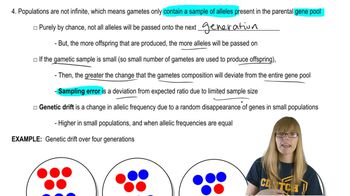Three pairs of genes with two alleles each (A₁ and A₂, B₁ and B₂, and C₁ and C₂) control the height of a plant. The alleles of these genes have an additive relationship: Each copy of alleles A₁, B₁, and C₁ contributes 6 cm to plant height, and each copy of alleles A₂, B₂, and C₂ contributes 3 cm. Identify all possible genotypes for plants with an expected height of 33 cm.
Table of contents
- 1. Introduction to Genetics51m
- 2. Mendel's Laws of Inheritance3h 37m
- 3. Extensions to Mendelian Inheritance2h 41m
- 4. Genetic Mapping and Linkage2h 28m
- 5. Genetics of Bacteria and Viruses1h 21m
- 6. Chromosomal Variation1h 48m
- 7. DNA and Chromosome Structure56m
- 8. DNA Replication1h 10m
- 9. Mitosis and Meiosis1h 34m
- 10. Transcription1h 0m
- 11. Translation58m
- 12. Gene Regulation in Prokaryotes1h 19m
- 13. Gene Regulation in Eukaryotes44m
- 14. Genetic Control of Development44m
- 15. Genomes and Genomics1h 50m
- 16. Transposable Elements47m
- 17. Mutation, Repair, and Recombination1h 6m
- 18. Molecular Genetic Tools19m
- 19. Cancer Genetics29m
- 20. Quantitative Genetics1h 26m
- 21. Population Genetics50m
- 22. Evolutionary Genetics29m
3. Extensions to Mendelian Inheritance
Overview of interacting Genes
Problem 11a
Textbook Question
In selective breeding experiments, it is frequently observed that the strains respond to artificial selection for many generations, with the selected phenotype changing in the desired direction. Often, however, the response to artificial selection reaches a plateau after many generations, and the phenotype no longer changes as it did in past generations. What is the genetic explanation for the plateau phenomenon?
 Verified step by step guidance
Verified step by step guidance1
Understand that artificial selection involves choosing individuals with desirable traits to reproduce, thereby increasing the frequency of alleles associated with those traits in the population over generations.
Recognize that the plateau phenomenon occurs when the response to selection diminishes and eventually stops, meaning the phenotype no longer changes significantly despite continued selection.
Explain that one genetic reason for the plateau is the depletion of genetic variation. Over successive generations, alleles contributing to the selected trait may become fixed (reach a frequency of 1), leaving no further genetic variation for selection to act upon.
Consider the role of natural selection and pleiotropy. Some alleles that enhance the selected trait may have negative effects on other traits or overall fitness, leading to a balance between artificial selection and natural selection pressures.
Discuss the possibility of reaching a physiological or developmental limit. Even if genetic variation remains, the phenotype may reach a biological constraint where further improvement is not possible due to the organism's inherent limitations.
 Verified video answer for a similar problem:
Verified video answer for a similar problem:This video solution was recommended by our tutors as helpful for the problem above
Video duration:
3mPlay a video:
Was this helpful?
Key Concepts
Here are the essential concepts you must grasp in order to answer the question correctly.
Artificial Selection
Artificial selection is a process in which humans intentionally breed individuals with desirable traits to produce offspring that exhibit those traits. This method is commonly used in agriculture and animal husbandry to enhance specific characteristics, such as size, yield, or temperament. Over generations, this selective pressure can lead to significant changes in the phenotype of a population.
Recommended video:
Guided course

Artificial Selection
Genetic Variation
Genetic variation refers to the differences in DNA sequences among individuals within a population. This variation is crucial for evolution and selective breeding, as it provides the raw material for selection to act upon. When a population is subjected to artificial selection, the initial genetic diversity allows for rapid changes in phenotype, but as the most favorable alleles become fixed, the available genetic variation diminishes, leading to a plateau in further changes.
Recommended video:
Guided course

Genomic Variation
Genetic Drift and Fixation
Genetic drift is a mechanism of evolution that causes allele frequencies to change randomly over time, particularly in small populations. As certain traits are selected for, alleles associated with those traits may become fixed, meaning they reach a frequency of 100% in the population. Once fixation occurs, the potential for further phenotypic change diminishes, contributing to the plateau effect observed in selective breeding experiments.
Recommended video:
Guided course

Genetic Drift

 7:56m
7:56mWatch next
Master Interacting Genes Overview with a bite sized video explanation from Kylia
Start learningRelated Videos
Related Practice
Textbook Question
505
views
